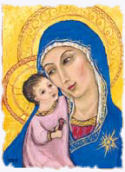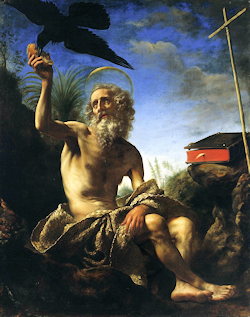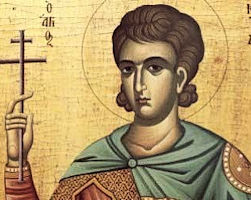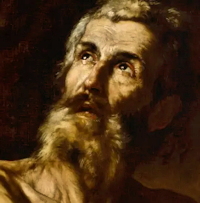Christmas: January 10th
Friday Christmas Weekday
Other Commemorations: St. Paul, the First Hermit (RM); St. Miltiades, Pope and Martyr (RM)
» Enjoy our Liturgical Seasons series of e-books!
Historically today is the feast of St. William of Bourges, Cistercian bishop who distinguished himself by his austerities, concern for the poor, the defense of the rights of the Church against the French crown, and his success in converting many members of the Albigensian heresy.
Christmas Weekday—Day Seventeen Every country in the world has its own Christmas customs. Christmas in Australia is often very hot. Whereas the northern hemisphere is in the middle of winter, Australians are baking in summer heat. It is not unusual to have Christmas Day well into the mid 30 degrees Celsius, or near 100 degrees Fahrenheit.
Every country in the world has its own Christmas customs. Christmas in Australia is often very hot. Whereas the northern hemisphere is in the middle of winter, Australians are baking in summer heat. It is not unusual to have Christmas Day well into the mid 30 degrees Celsius, or near 100 degrees Fahrenheit.
A traditional meal includes a turkey dinner, with ham, and pork. A flaming Christmas plum pudding is added for dessert. In the Australian gold rushes, Christmas puddings often contained a gold nugget. Today a small favor is baked inside. Whoever finds this knows that they will enjoy good luck. Another treat is Mince Pies.
It is Father Christmas who brings the presents to the Australian children on Christmas Eve. Homes and gardens are decorated with greenery, Christmas tree and fairy lights. Seasonal plants are the Christmas bush and the Christmas bell.
- Day Seventeen activity (Candles by Candlelight)
- Day Seventeen recipe (Australian Christmas Pudding)
St. Paul, Hermit
St. Paul is called "the first hermit" in the Missal and Breviary, a rare distinction, for such titles are seldom  appended. Our saint was the standard-bearer of those courageous men who for the love of Christ left the world and entered the wilderness to dedicate themselves wholly to contemplation amid all the privations of desert life. The hermits were the great men of prayer in those difficult times when the Church was locked in fierce struggle with heresy after heresy. For centuries the example of their lives served as the school of Christian perfection. Their action set the background for the rise of monasticism and religious orders in the Church.
appended. Our saint was the standard-bearer of those courageous men who for the love of Christ left the world and entered the wilderness to dedicate themselves wholly to contemplation amid all the privations of desert life. The hermits were the great men of prayer in those difficult times when the Church was locked in fierce struggle with heresy after heresy. For centuries the example of their lives served as the school of Christian perfection. Their action set the background for the rise of monasticism and religious orders in the Church.
The Breviary retains an edifying legend concerning today's saint. One day St. Anthony, then ninety, was divinely inspired to visit the hermit Paul. Though they had never met previously, each greeted the other correctly by name. While they were conversing at length on spiritual matters, the raven that had always brought Paul half a loaf of bread, came with a whole loaf. As the raven flew away, Paul said: "See, the Lord, who is truly good and merciful, has sent us food. Every day for sixty years I have received half a loaf, but with your arrival Christ sent His servants a double ration." Giving thanks, they ate by a spring.
After a brief rest, they again gave thanks, as was their custom, and spent the whole night praising God. At daybreak Paul informed Anthony of his approaching death and asked him to fetch the cloak he had received from St. Athanasius, that he might wrap himself in it. Later, as Anthony was returning from his visit, he saw Paul's soul ascending to heaven escorted by choirs of angels and surrounded by prophets and apostles. Further traditional matter may be found in The Life of Paul the Hermit, written by St. Jerome about the year 376.
Patronage: Clothing industry; weavers; basket weavers; hermits; Order of Saint Paul the First Hermit
Symbols and Representation: Dead man whose grave is being dug by a lion; man being brought food by a bird; man clad in rough garments made of leaves or skins; old man, clothed with palm-leaves, and seated under a palm-tree, near which are a river and loaf of bread; pictured with Saint Anthony the Abbot.
Highlights and Things to Do:
- Bake a loaf of bread to celebrate this feast, as it is recounted in the Golden Legend how St. Paul received his daily bread every day from God.
- Read St. Jerome's account of the Life of St. Paul.
- The Order of St. Paul the Hermit (Paulines) runs the Shrine of Our Lady of Czestochowa in Doylestown, PA. Read more about the order and if in the neighborhood pay a visit (or a virtual visit) to the Shrine.
- See the Community of Blessed Eusebius which prayerfully supports the Order of Saint Paul the First Hermit.
- Read about St. Paul the Hermit:
- See the statue of St. Paul the Hermit at St. Peter's Basilica Colonnade.
- See some iconography of St. Paul.
Pope St. Miltiades (also known as St. Melchiades)
 Two popes had been exiled by Emperor Maxentius, and for nearly two more years the Church in Rome was steeped in turmoil, making it impossible to choose a pope. Finally, Miltiades, an African, was elected. He had served as a priest under Marcellinus during the terrible Diocletian persecution. Now, however, he witnessed the effects of a kinder, more generous Roman government. Indeed, the Church would actually be favored with splendid gifts. By 311 the Church began to enjoy a peace resulting from a decree of toleration issued in both the East and the West. Emperor Maxentius ordered the properties of the Church restored. These included the land and buildings that had been confiscated during the reign of Emperor Diocletian. In 312 for the first time since the outbreak of persecution, a pope was able to preside over the celebration of Easter in full possession of the Church's holy assets.
Two popes had been exiled by Emperor Maxentius, and for nearly two more years the Church in Rome was steeped in turmoil, making it impossible to choose a pope. Finally, Miltiades, an African, was elected. He had served as a priest under Marcellinus during the terrible Diocletian persecution. Now, however, he witnessed the effects of a kinder, more generous Roman government. Indeed, the Church would actually be favored with splendid gifts. By 311 the Church began to enjoy a peace resulting from a decree of toleration issued in both the East and the West. Emperor Maxentius ordered the properties of the Church restored. These included the land and buildings that had been confiscated during the reign of Emperor Diocletian. In 312 for the first time since the outbreak of persecution, a pope was able to preside over the celebration of Easter in full possession of the Church's holy assets.
Pope Miltiades worked diligently in a difficult time of transition. His edicts included forbidding the Christians to fast on Thursday and Sunday (the days during which the pagans kept their fasts) and directing that the Eucharist plate blessed by the bishop be carried to the various churches.
Constantine, having been proclaimed emperor in Gaul, now marched on Rome. The sign of the cross had been revealed to him in a vision where he was told that "by this sign shalt thou conquer." Constantine ordered his standards changed, and for the first time in history, the sign of peace was borne by an army. Constantine's legions defeated Maxentius, and the year 312 ushered in a new era, an era of peace; the Christians were truly set free. During the emperor's stay in Rome, the famous Lateran palace was given to Pope Miltiades by Fausta, Constantine's wife. The Lateran served as the papal residence for some four hundred years.
Less than a year later, a schism broke out in North Africa. Headed by a rigorist named Donatus, the faction objected to the policies of the bishop of Carthage, Caecilian. Bypassing the pope, they appealed directly to Constantine to intervene. The emperor, annoyed that he should be called on to settle disputes among the clergy, commissioned Miltiades and three other Gallic bishops to rectify the matter. The pope gathered fifteen additional bishops and held a synod in the great Lateran palace. The decision of this synod was to condemn Donatus and his party and to support the true bishop, Caecilian. The Donatists (as they later became called) appealed again to Constantine, but by the time another council could be called, Pope Miltiades had died.
St. Miltiades was an excellent pontiff who guided the Church wisely during a difficult time of changeover. Pope Miltiades was the last pope to be buried in a catacomb in the cemetery of Calixtus. His feasts was originally celebrated on December 10, but moved to January 10 in the calendar revision of 1969.
—Excerpted from The Popes: A Papal History, J.V. Bartlett
Highlights and Things to Do:
- Read more about the Pope St. Miltiades:
- St. Miltiades is often venerated as one of 3 of the black popes.
- Pope St. Miltiades is buried in the Catacombs of St. Calllixtus along the Appian Way.






